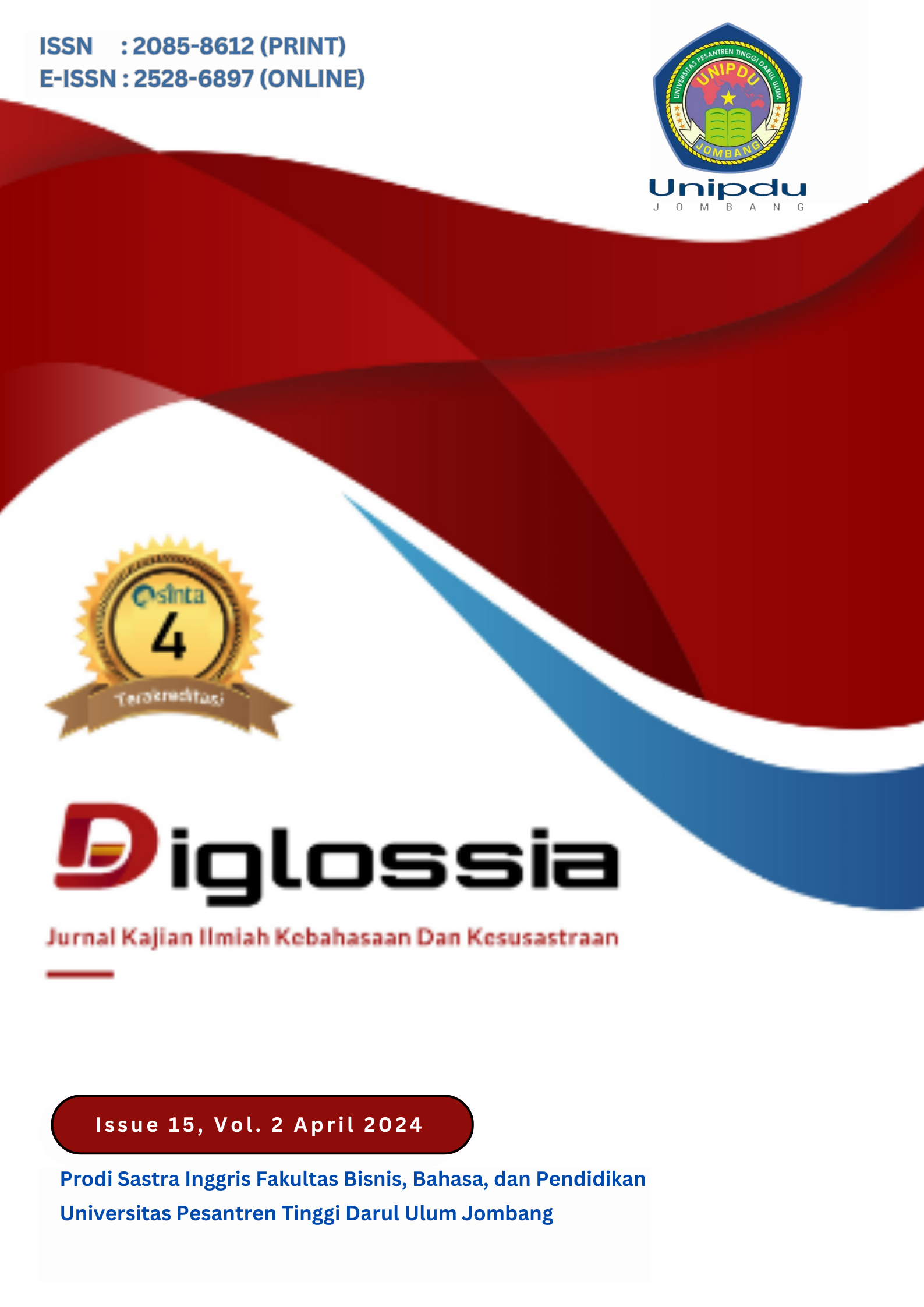Analysis Of Suffixed Words of Plywood Manufacturing Article
DOI:
https://doi.org/10.26594/diglossia.v15i2.4456Keywords:
affixation, suffix, derivation and inflection, plywood industryAbstract
The purpose of this research to find out and analyze suffix word of the manufacturing process. The primary goal of this research is to determine how the suffixing process occurs in the manufacturing plywood. Plywood stands as a foundational building material, comprising thin wood layers or plies bonded together with adhesive. It divides into two primary categories: softwood plywood and hardwood plywood, each aligning with specific tree species. Coniferous varieties, such as firs and pines, predominantly contribute to softwood plywood, while deciduous species, including oak, poplar, maple, cherry, and larch, find prominence in hardwood plywood.
Softwood plywood undergoes production by bonding multiple layers of dry softwood veneers with adhesive. Its versatile applications encompass wall siding, sheathing, roof decking, concrete formboards, floors, and containers. Within industrial classifications, it falls under Standard Industrial Classification (SIC) code 2436 and North American Industrial Classification System (NAICS) code 321212 for "Softwood Plywood and Veneer."
On the other hand, hardwood plywood emerges from the bonding of hardwood veneers using adhesive. The face and back layers encase a core, typically composed of lumber, veneer, particleboard, or medium density fiberboard. Hardwood plywood manifests in various forms, from panels to specialized components like curved hardwood plywood, seat backs, and chair arms. Its domain of application extends to interior uses such as furniture, cabinets, architectural millwork, paneling, flooring, store fixtures, and doors. Classified under SIC code 2435 and NAICS code 321211 for "Hardwood Plywood and Veneer," this type of plywood showcases a distinct production process.
References
Adela Indah Nurjanah. (2021): Different Suffix and Preffix in Analysis Article.
Andrew. (2022). Business Feasibility Study For The Development of Plywood Plant. PT Multi Mustika Agung.
Aslamiah, S. (2020, 26 September). The Use Of Prefixes and Suffixes for Increasing Vocabulary Student. FIKRUNA, 2(1), 41-55.
Chofifah Wulandari. (2022). Analysis Of Defective Products In the Plywood Production Process, Samarinda.
Dewangga A, and S. Suseno, “Analisa Pengendalian Kualitas Produksi Plywood Menggunakan Metode Seven Tools, Failure Mode And Effect Analysis (FMEA), Dan TRIZ”, JTMIT, vol. 1, no. 3, pp. 243–253, Oct. 2022.
Dinda Tria Pratiwi (2020). Analysis in the Plywood Production Process. Faculty of Enineering, Veterans National Development University
Fitria, T. N. (2020). An Analysis of Derivational and Inflectional Morpheme in Selected News from Tempo. Co. Rainbow: Journal of Literature, Linguistics and Culture Studies, 9(2), 146–155.
Ganjar O.W. (2022). Analysis Plywood Production Unit Costs and Revenues (Study PT. Salas Ambas Lestari)
Gultom, S. M. (2014). Derivational and Inflectional Processes in Some Selected Articles
Harleyda Dewi, N. L. P. A. A., Agustia, K. T. S., & P. Suyasa, N. L. C. (2022). ANALISIS SUFFIX DERIVATIONAL PADA ESAI MOTIVASI MAHASISWA KELAS INTERNASIONAL UNIVERSITAS DHYANA PURA: STUDI MORFOLOGI. Seminar Ilmiah Nasional Teknologi, Sains, Dan Sosial Humaniora (SINTESA), 4. Retrieved from https://jurnal.undhirabali.ac.id/index.php/sintesa/article/view/1675Roani R. (2019). Preffix and Suffix Analysis in Relation with Students English Ability
Hutaminingrum, M. P. D. (2022). An Analysis of Affixation Processes of Derivation and Inflection in Article with the Title “The Government of the Republic of Indonesia”. Linguistics Initiative, 2(1), 70–76. https://doi.org/10.53696/27753719.2132Moses Laksono Singgih. (2020). Implementation Lean Manufacturing Method of Plywood Manufacture Company.
Panjaitan, H. I., Togatorop, N. R., & Damanik, D. A. (2020). THE ANALYSIS OF FINDING SUFFIX AND PREFIX IN NARRATIVE TEXT. Jurnal Bahasa Indonesia Prima (BIP), 2 (1), 85-89. https://doi.org/10.34012/bip.v2i1.897
Siyaswati (2019). The English Inflectional Suffixes and Derivational Affixes in Elt. Department of English Education. The University of Muhammadiyah Surabaya
Meisya Zahira. (2022). Analysis of Suffixed Words in Los Angeles Time Newspaper.Universitas Dian Nuswantoro.
Tahir, M., Rahayu, H., Ali, A., Idris, I., & Suputra, G. (2023). Morphological Error Analysis in Students' Explanatory Text : An Analysis Based on Gender. Jurnal Kependidikan: Jurnal Hasil Penelitian dan Kajian Kepustakaan di Bidang Pendidikan, Pengajaran dan Pembelajaran, 9(1), 347-355. doi:https://doi.org/10.33394/jk.v9i1.7129
Putrayasa, B. I. P. (2019). Kajian Morfologi (Bentuk Derivasional dan Infleksional) (Bandung).
Taufiq R. (2022). Kekuatan Tarik plywood dari bahan sengon (ALBIZIA CHINENSIS)
Tengku N. (2023). Value Stream Mapping in the Plywood Production Process to Improve Process Cycle Efficiency.
Swadesh Kumar (2018). Process Parameters for Plywood Manufacturing. International Journal (2022). A Study on Analysis of Product Quality Problems in Plywood Production.
Qossam, Muhammad Izzuddin Al. (2019). Analysis of Competitiveness and Market Structure Indonesian Plywood on The Market International. Malang: University Brawijaya
Liang-liang Jia. (2019). Life Cycle Assessment of Plywood Manufacturing Process, University Yangling.
Downloads
Views: 249 | Downloads: 87
Published
How to Cite
Issue
Section
License
Copyright (c) 2024 Diglossia: Jurnal Kajian Ilmiah Kebahasaan dan Kesusastraan

This work is licensed under a Creative Commons Attribution 4.0 International License.
- Authors who submit a manuscript to this journal and accepted for publication, copyright of the article shall be assigned to the authors of the article.
- Copyright encompasses exclusive rights to reproduce and deliver the article in all forms and media, including reprints, photographs, and any other similar reproductions, as well as translations. The reproduction of any part of this journal, its storage and transmission of databases by any forms or media, such as electronic, mechanical copies, photocopies, and recordings will be allowed by Diglossia
- Editorial Board of Diglossia tries to make every effort to ensure that no wrong or misleading data, opinions or statements be published in the journal. The contents of the articles published to Diglossia are sole and exclusive responsibility of their respective authors.
- The copyright form should be filled with respect to article and be signed originally and sent scanned document file (softcopy) and the article to our email, jurnal.diglossia@fbs.unipdu.ac.id or sent it to the Editorial Office in the form of original hard copy and the article in softcopy form on Flash Disc or Compact Disc, to;Diglossia: Jurnal Kajian Ilmiah Kebahasaan dan Kesusastraan
Prodi Sastra Inggris Fakultas Bisnis dan Bahasa
Universitas Pesantren Tinggi Darul Ulum
Kompleks Pondok Pesantren Darul Ulum
Rejoso Peterongan Jombang Jawa Timur 61481

